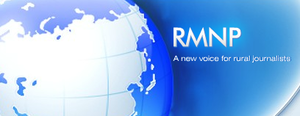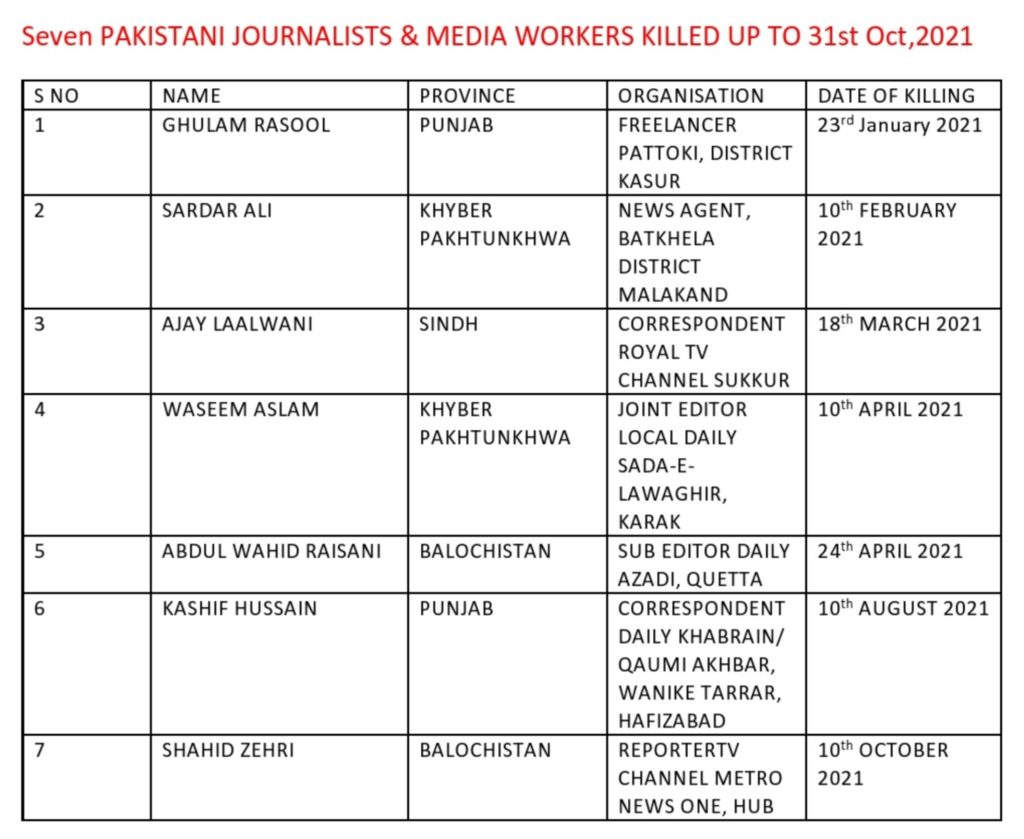Extracts from RMNP Report Attacks on Pakistan Media January to October 2021
Seven Pakistani journalists and media workers have been killed in Pakistan from January 2021 to 31st October 2021 out of which six belong to rural areas and small towns while only one journalist hails from Quetta, the capital of Balochistan province. This was disclosed in RMNP report issued in country language Urdu on the eve of the International Day to End Impunity for Crimes against Journalists (2nd November 2021). As per the monitoring of the Rural Media Network Pakistan (RMNP), two persons including one journalist and a media worker killed in Punjab province, one journalist in Sindh province, two journalists each in Balochistan and Khyber Pakhtunkhwa provinces.
According to the RMNP report, Pakistan is still one of the most dangerous countries for practicing journalism and since 2000, majority of the journalists who killed in the line of duty were residents of rural areas and small towns where 65 percent Pakistani population is living. It was stated in the report that as the result of Pakistani media’s repeated demands, long-awaited ” Protection of Journalists and Media Professionals Bill, 2021″ was approved by the federal cabinet and tabled in National assembly in May 2021.Moreover the Standing Committee of the National Assembly (NA) on Human Rights gave approval the Protection of Journalists and Media Professionals Bill 2021 in its meeting held in September 2021 with amendment and now the bill will be presented before the National Assembly for further consideration. RMNP report further stated this bill has already been unnecessarily delayed. It took two and a half years for preparing the bill and it is an issue all parties are not on board with. Since the government has been publicly highlighting work on this bill, the opposition needs to put aside its differences and help the government in the approval of this bill unanimously—it should not be left gathering dust for any longer. RMNP also cautioned that media practitioners in the country remain vulnerable to physical, legal, and digital threats due to the absence of legislation for their safety.
RMNP Assessment
RMNP in its assessment said that freedom of expression witnessed notable declines during pandemic and this year. Pakistan’s federal cabinet approved the establishment of “Pakistan Media development Authority” to sweep new powers to control digital, electronic, and print media. Journalists’ organizations, media houses and press freedom groups opposed this proposed legislation unanimously while international press freedom and human rights organisations expressed their solidarity with Pakistani media. RMNP has also turned down the proposed Pakistan Media Development Authority (PMDA) unanimously in its meeting held in September 2021.RMNP called PMDA “an unconstitutional and draconian law against the freedom of press and expression. RMNP meeting said that the proposal is aimed at tightening the Centre’s control over the media through a single platform, ignoring the fact that each of the print, electronic and social media are separate entities having their own defined features. The move to bring [them] under state control smacks of an authoritarian streak that should have no place in democratically elected dispensation, RMNP statement said. It was stated that the “proposed legislation would not only deprive journalists and media organisations of the press freedom but would also deprive civil society, students, lawyers, teachers, law makers, trade unions, political, religious activists and in fact 220 million population of Pakistan of their basic rights. Participants of the meeting while expressing their views said the freedom of press in Pakistan in under threat as the PTI government led by Premier Imran Khan is poised to place more curbs by introducing so-called new law Pakistan Media development Authority (PMDA).
They further said the PMDA law would grant new unchecked powers to the government-controlled regulator by setting up special “media tribunals” that will have the power to impose steep fines for media organizations and journalists who violate its code of conduct or publish content it deems to be “fake news.” The proposed law would also increase government control by allowing government officials to be appointed to key positions. The media regulatory framework in Pakistan does need to be amended – not to centralize more powers in government censors, but to create independent media regulators dedicated to protecting free expression. With journalists under relentless attack for doing their jobs, the Pakistan government needs to stop trying to control media and instead start protecting media freedom, they demanded.
President RMNP Ehsaan Ahmed Sehar cited RMNP annual press freedom report which says that the government has circumvented articles 19 and 19A of the Constitution, 1973, by suppressing, imposing censorship, using PEMRA, issuing advices and intimidating by use of force the media in Pakistan.
PEMRA actions against Independent TV channels
During current year 2021, PEMRA suspended the licence of BOL TV and imposed PKR one million fine. It also served show cause notices to 14 TV channels for airing fake news regarding increase in the prices of petroleum products. PEMRA advised news TV channels not to air unsubstantiated remarks about the National Accountability Bureau (NAB). On April 16,2021 PEMRA banned the coverage of religious organisation” Tehreek-e-Labbaik Pakistan demonstrations on TV Channels and directed TV channels on April 28,2021 to rely on information from Information Minister and other ministers regarding decisions of the Pakistani cabinet meetings. On 21st October 2021, PEMRA issued advice regarding caress/hug scenes dramas. It banned the coverage of TLP on TV Channels and suspended the transmission of BOL TV on 28th October 2021 without any notice and warning on the charge of airing TLP procession.
Online Harrasment of Media Personnels
Many male and female journalists have set up their YouTube Channels in Pakistan including those leading anchors who have been taken off air by their respective TV Channels due to their criticism on military and government. In the sphere of Online media, journalists are receiving threats and abuse from individuals and even ruling party leaders besides activists. During current year female journalists remained target as previous year 2020 for their critic reporting and TV programmes. In September 2021, TV anchor Gharida Farooqi, female journalist Benazir Shah and in October female TV anchor Asma Shirazi became the targets of government ministers and ruling party leaders.
Attacks on Journalists, Arrests, Detentions, Cases& Raids
RMNP has recorded 33 incidents of attacks on journalists related with their work. Similarly, 12 incidents of detentions, arrests also occurred in different areas of the country. Cases against 17 journalists were also reported from different parts of the country during this year. Jang-Geo group was attacked by demonstrators in Karachi, while Karachi Press Club also attacked by JUI(F) activists.
According to RMNP Annual Press Freedom Report 2020-2021, Covid-19 has taken the lives of at least twenty-six Pakistani journalists and media practitioners and it also brought new challenges in terms of press freedom. As per RMNP monitoring two TV reporters Saeed Ali Achakzai and Abdul Mateen Achakzai were tortured for reporting at a quarantine centre near Afghan border. G-News Bureau Chief Arsalan Ahmed arrested in Peshawar as he covered lockdown violations exposing the KP government failure to control the spread of coronavirus. Fake cases were registered against working journalists in Khairpur and Kashmor districts of Sindh province. One Jang correspondent Azhar Ali Danish was badly beaten by a law-enforcing agency while covering women standing outside an Ehsas centre in Uchsharif town of Bahawalpur district.
Threats
Journalists facing different threats in certain areas of the country, varying from influential figures harassing journalists who report on honour killing and gang rape incidents, to targeting by the militants and even security agencies. Authorities often falsely accuse journalists of various crimes should they carry out work exposing corruption. Other important constraints on media freedom which impinge on journalists’ ability to do their work are the cultural of secrecy and the levels of bureaucracy concerning access to official information. “Journalists find it almost impossible to find information related to large government deals or projects, and ministries remain tight-lipped on their activities and finances, denying access to information for journalists,” Similarly, the Pakistan Electronic Media Regulatory Authority (PEMRA) has been used to silence the broadcast media by either suspending licenses or simply threatening to do so. In addition, media houses are also exposed to propaganda from state agencies, pressured by powerful political elements and non-state actors involved in the current conflict to publish what they are spoon-fed.
Urban versus rural threats
While these threats face journalists working throughout Pakistan, RMNP would suggest – focused on addressing issues confronted by members of the media working in rural areas. “Urban-based journalists are paid and have support from their respective media organisations and official publicity departments,” “they are being provided maximum facilities by media owners because of the media ownership in the cities.” There is no comprehensive system to act when a rural journalist is attacked, kidnapped, or tortured. No one is aware of any hotline for assistance, “rural journalists have no contact with the journalist bodies active in big cities. “Some rural journalists, also known as district correspondents, are engaged by media organisations for reporting news and views from the rural areas. “Historically the development of media in Pakistan has taken place in metropolitan centres, “this is not unique to Pakistan, however what is perhaps different in the Pakistani context is that the development has not filtered down to rural areas. “As a result, rural journalists remain neglected, often working in isolation with extremely limited support from media organisations in financial, moral and professional terms
Topics deemed off-limits
Unfortunately, caught between the various powers at play in the rural areas of Pakistan, journalists often find themselves facing threats and ultimatums. “Censorship in Pakistan used to be straightforward. Certain topics were simply off limits,” the situation is more complicated and more confusing. “However, there are still many topics which are basically deemed no-go subjects for journalists. These include articles critical of the military or government, judiciary investigative reports, and any reporting on the militant groups. Journalists in rural areas face the same constraints as their colleagues in the city, but also face serious additional issues because of their location and the social differences in those areas. For journalists in rural areas, corruption, sectarianism, honour killings, gang rape and feudal powers all represent subject matter that can cause serious issues.
List of seven journalists who were killed in all four provinces of Pakistan from January to October 2021.
Source: RMNP




